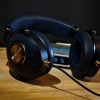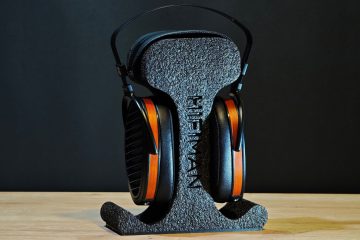Introduction
The Sendy Audio Apollo stands out for its dynamic driver-like timbre and good staging. But there are some problems, like a lack of texture and a non-isobaric frequency response. I will cover all these in detail. The product in my hand was purchased by myself for the purpose of writing an independent review. The original price of the product is $500, but it can be found on the market for as low as $340. For the purposes of this review, I will use the $460 price as the most common price I come across.

Build
Sendy Audio Apollo comes in a big box. It comes with a very sturdy and protected carrying case, a hemp bag for the cable and a 4.4mm to 3.5mm converter. All the materials used are of good quality and you can feel it.
Good appearance, sturdy, functional, comfortable and quality material. The combination of wood with metal results in a good design and build quality. Large drivers require large cups, which increases the weight. But this is not a problem because the headband and pads keep the comfort at a good level.
There is a layer of what looks like fiberglass in front of the driver, which is exposed when the pads are removed. I will examine the effects of this layer on the sound in the sound section.

Drivealbility and Synergy
Even though it is 16ohm, the desktop needs a source. In my tests, the Hiby FC6 fell short in terms of power, while the Fiio K11 R2R H gain mode was sufficient in the 30-40/99 volume range (I expected this, the FC6 is not made to drive over-ear headphones). In terms of snergy, the Sendy Audio Apollo doesn’t get along well with bright sources. It matches with analog and comparatively warmer sources. On the other hand, it may not be a good match with extremely warm sources.

Sendy Audio Apollo With K11 R2R
The K11 R2R and Sendy Audio Apollo are a good match. The two together are very well balanced. The K11 R2R easily drives the Apollo in terms of power. Frankly, I liked the sound I heard from the 6.3mm output more and found it more tonally suitable. However, since I used two different adapters while doing this, I will write this review based on my direct listening with 4.4mm. Because this is a much more reasonable and practical scenario.

Sound
In technical terms, the Sendy Audio Apollo is average in terms of resolution among planar driver headphones. But when it comes to stage and imaging, it’s quite impressive. However, there is a condition for this, which is to listen at a relatively low volume. Listening at very high volumes causes two small roll-offs in front of and behind the peak between 5-6Khz. This causes a bit of texture loss and a bit of blending in the instruments in that section. Still, it’s not that big of a problem if you consider that it only happens at very high volumes. Because the “ relatively low volume” I mentioned is quite enough and it is possible to hear quite natural instruments at this level. My comments throughout the review will be based on this listening level.
Technics
We mentioned that it has a normal resolution and good imaging. Apart from that, instrument accuracy and layering are great. Separation is average. Details are quite clear and distinct, but microdetail reproduction is average with a very slight lack of texture in the midrange. Soundstage width is good, depth is slightly above average and the spatial stage is great. Another aspect of this is that the amount of extension in the upper and lower frequencies is quite natural and realistic. This combined with a good soundstage means good imaging.

Timbre
The fiberglass-like layer in front of the drivers reminded me of the old phenomenon of putting napkins in the cup of headphones with planar drivers. Old users of various forums will also remember it. Back to the topic at hand, I think this layer has caused some good things and some bad things. The good thing is that the sound has moved away from the bright and unwanted planar sound to a more natural, dynamic driver-like sound. I also think it has a good effect on the lower frequency response. The bad thing is that such a layer has a bad effect on the resolution. Still, all in all, it adds character to the headphones. The result is a natural and reasonable timbre for a planar driver.
Bass
It has a great lower bass extension for a headphone with planar drivers. And overall the lower frequencies are fast, accurate and realistic. In the spectrum, the lower frequencies are in the background, but they reflect the emotion and dynamics of the music as they should. You can easily understand this by listening to the bass guitar in Mars Red Sky – Strong Reflection with these headphones. It’s not perfect for electronic music, but it will save the day for pop and hip-hop.
Mid
Sendy Audio Apollo works well in the mid frequencies, especially with strings and wind instruments, but loses texture when the quantity of instruments increases. It’s not at its best when listening to large groups, but works great with less complex tracks. The instruments can sometimes lack body, but the vocals are very full and well-built. The mids are not very transparent and become unbalanced as the volume increases. Other than that, the mids are acceptably average for the price. They are not bad, but there is nothing to praise.
Treble
Natural and balanced. Where Apollo succeeds quite well is in the treble. There is not much extension and the air frequencies are a little behind. But because it is well tuned, it has very natural and realistic cymbals. I think the track that best expresses the Sendy Audio Apollo’s treble performance is Dire Straits – Sultans Of Swing. Both the cymbals sound great and the details extending to the lower treble are clear. All of this combined with an undisturbing and harmonious treble structure throughout the sound, the Apollo plays naturally at this point.

Hifiman Edition XS [$379(now $269)] vs Sendy Audio Apollo ($460)
Both are well-built, but the Apollo stands out for its carrying case. Both are quite comfortable, but the Hifiman Edition XS is a bit more comfortable while the Apollo is lighter. When it comes to audio, the Edition XS is by far the better for resolution and detail retrieval. On soundstage and imaging, they’re about equal. In terms of texture, the Edition XS is better, while the Apollo is relatively more bodied. For separation and layering, Edition XS is better, while Apollo excels in positioning. In terms of tonality, Edition XS is brighter, whereas Apollo has a softer tone. Apollo has better response in the lower frequencies, while the Edition XS is overwhelmingly superior in the mids. While both are good in the treble, the Edition XS is more technical while the Apollo is a bit more natural in the treble. The Edition XS has more microdetail reproduction and higher resolution across the entire spectrum. Apollo has a more natural tone in the bass and treble.
The truth is that even if the prices were equal, many people would prefer the Editon XS. Today, however, the Apollo is almost $200 more expensive, making it unreasonable. On the other hand, it’s not the Apollo that’s too expensive, it’s the Edition XS that’s too cheap. There’s nothing to say, it’s a free market.
Last Words
Sendy Audio Apollo seems to be a little behind the market. If the price were $250-$300, I might give it a higher rating, because it’s not a bad headphone, but it’s a bit expensive. Another important point is the fact that this headset really appeals to a minority.











